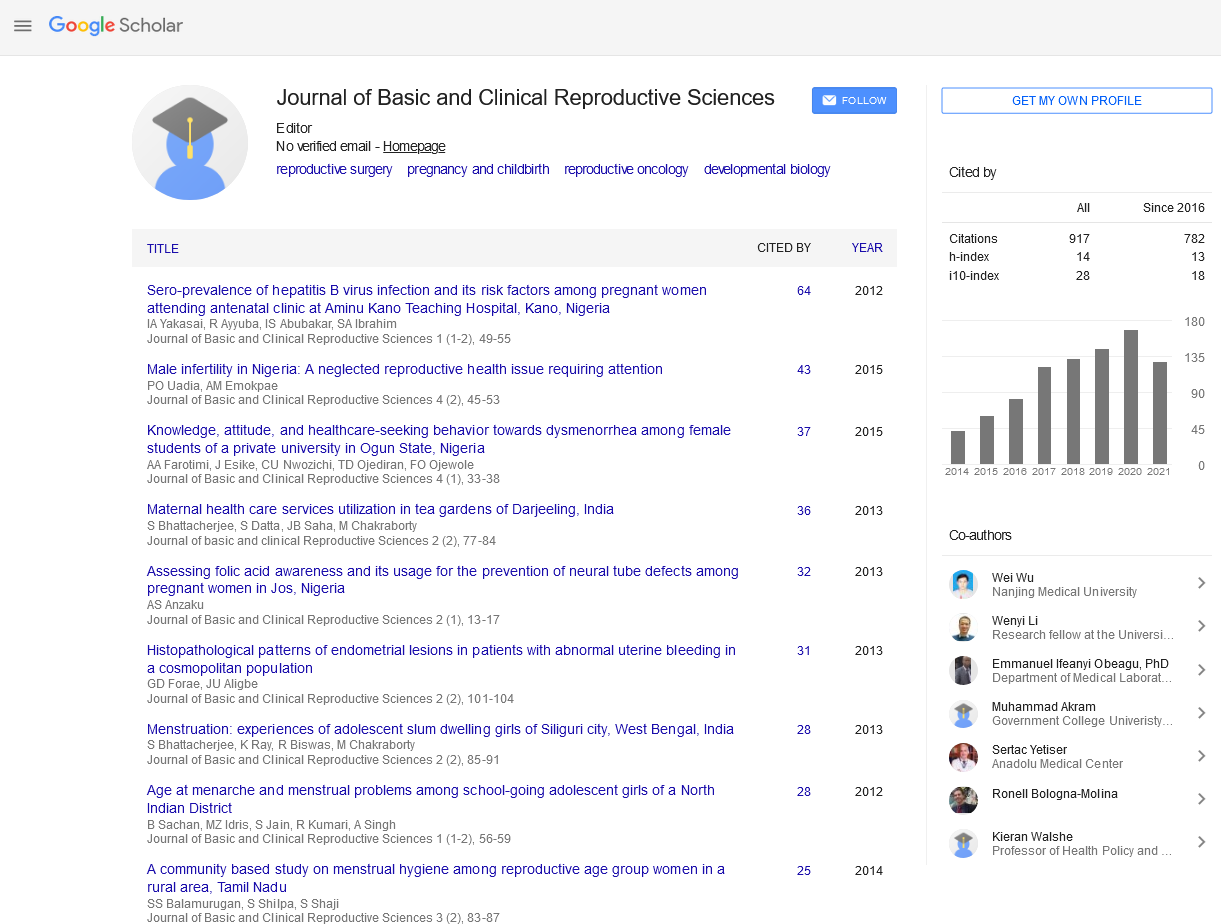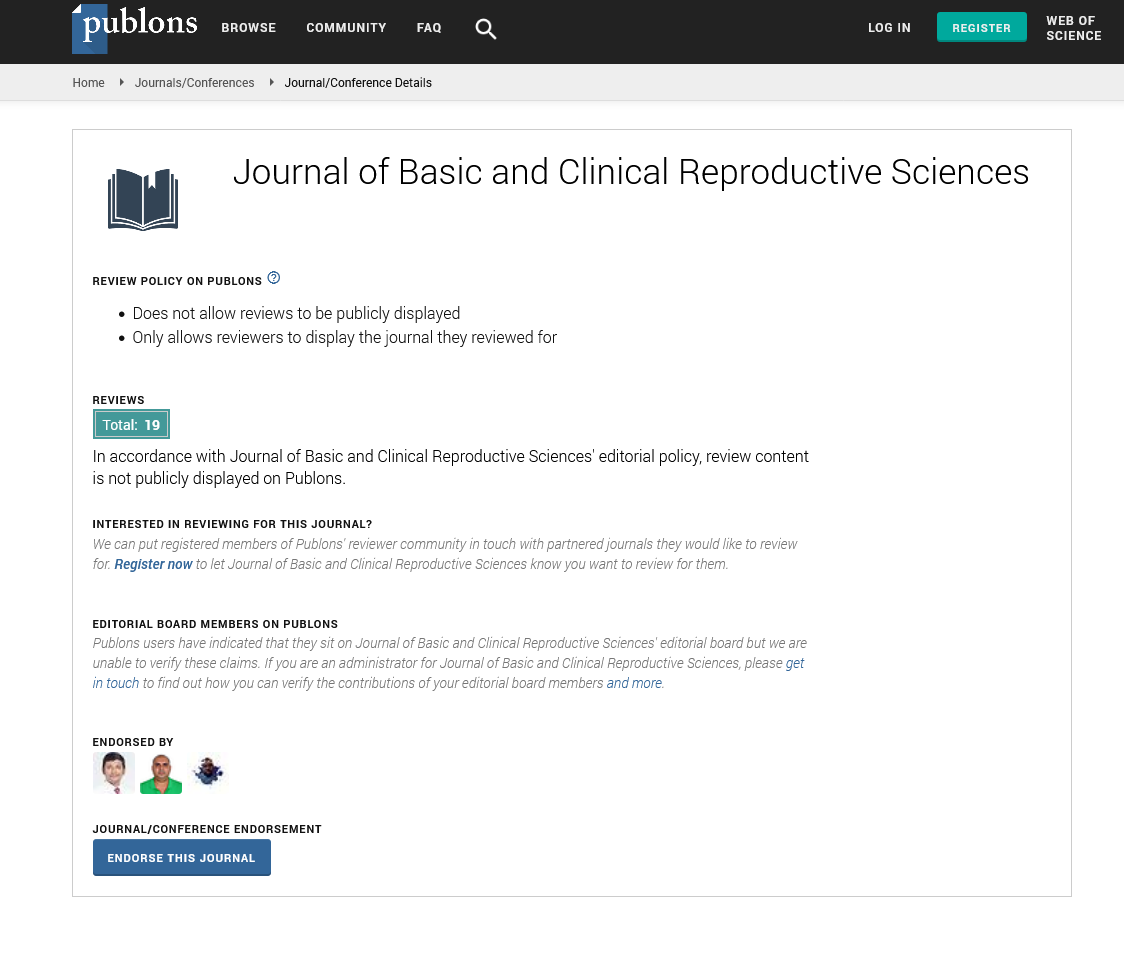Opinion - Journal of Basic and Clinical Reproductive Sciences (2023) Volume 12, Issue 3
Ovarian Cysts and Fertility: Understanding the Impact on Reproductive Health
Received: 24-May-2023, Manuscript No. JBCRS-23-101967; Editor assigned: 26-May-2023, Pre QC No. JBCRS-23-101967 (PQ); Reviewed: 09-Jun-2023 QC No. JBCRS-23-101967; Revised: 16-Jun-2023, Manuscript No. JBCRS-23-101967 (R); Published: 23-Jun-2023
This open-access article is distributed under the terms of the Creative Commons Attribution Non-Commercial License (CC BY-NC) (http://creativecommons.org/licenses/by-nc/4.0/), which permits reuse, distribution and reproduction of the article, provided that the original work is properly cited and the reuse is restricted to noncommercial purposes. For commercial reuse, contact reprints@pulsus.com
Description
Ovarian cysts are fluid-filled sacs that form on the ovaries and are a common gynecological condition that affects many women at some point in their lives. They are a common occurrence in women of reproductive age and can vary in size and shape. While most ovarian cysts are harmless and resolve on their own, some may cause discomfort and require medical attention. In this study, one can explore the causes, symptoms, and available treatment options for ovarian cysts.
Understanding ovarian cysts
Definition and types: Ovarian cysts are fluid-filled sacs that develop within or on the surface of the ovaries. There are two primary types of ovarian cysts: functional and pathological. Functional cysts, such as follicular and corpus luteum cysts, are a normal part of the menstrual cycle and typically resolve on their own. Pathological cysts, including dermoid cysts, endometriomas, and cystadenomas, are less common and may require medical intervention.
Causes: The exact causes of ovarian cysts are not fully understood. However, certain factors can contribute to their development, including hormonal imbalances, irregular menstrual cycles, endometriosis, and Polycystic Ovary Syndrome (PCOS). Age, family history, and previous ovarian cysts may also increase the risk of developing cysts.
Symptoms and diagnosis
Many ovarian cysts do not cause any noticeable symptoms and are discovered incidentally during routine pelvic examinations or imaging tests.
Common symptoms: When symptoms do occur, they may include pelvic pain or pressure, bloating, changes in menstrual patterns and frequent urination. Severe symptoms, such as sharp abdominal pain, fever, or vomiting, may indicate a potentially dangerous cyst requiring immediate medical attention.
Diagnostic procedures: To diagnose ovarian cysts, healthcare providers may perform a combination of pelvic examinations, ultrasound imaging, blood tests, and laparoscopy. These methods help determine the size, location, and composition of the cysts and rule out other possible conditions.
Watchful waiting: In many cases, especially with functional cysts, a “wait and see” approach is adopted, as these cysts often resolve on their own within a few menstrual cycles. Regular monitoring through follow-up appointments and imaging tests ensures the cyst does not grow or cause complications.
Medications: Hormonal birth control pills or other hormonal medications may be prescribed to regulate the menstrual cycle, prevent the formation of new cysts, or shrink existing ones. Nonsteroidal Anti-Inflammatory Drugs (NSAIDs) can also help alleviate pain associated with cysts.
Surgical intervention: If the cyst does not resolve on its own, causes severe pain, or poses a risk of rupture, surgical intervention may be necessary. Minimally invasive laparoscopic surgery is commonly used to remove cysts while preserving the ovary. In more complex cases or when cancer is suspected, a larger incision (laparotomy) may be required.
Management of pathological cysts: Pathological cysts, such as endometriomas or cystadenomas, may require more extensive surgical treatment. In some cases, the affected ovary or ovaries may need to be removed (oophorectomy) to prevent complications or reduce the risk of ovarian cancer.
Conclusion
Ovarian cysts are a common occurrence in women, with most being harmless and resolving on their own. However, some cysts can cause discomfort and require medical intervention. Understanding the causes, symptoms, and available treatment options for ovarian cysts is crucial for accurate diagnosis and appropriate management. Regular check-ups and communication with healthcare providers are essential in monitoring the condition and ensuring timely intervention when necessary. If one experiences persistent pelvic pain, changes in menstrual patterns, or other concerning symptoms, seeking medical advice is recommended to receive a proper diagnosis and personalized treatment plan. Remember, early detection and intervention can significantly improve outcomes and overall well-being for women affected by ovarian cysts.


